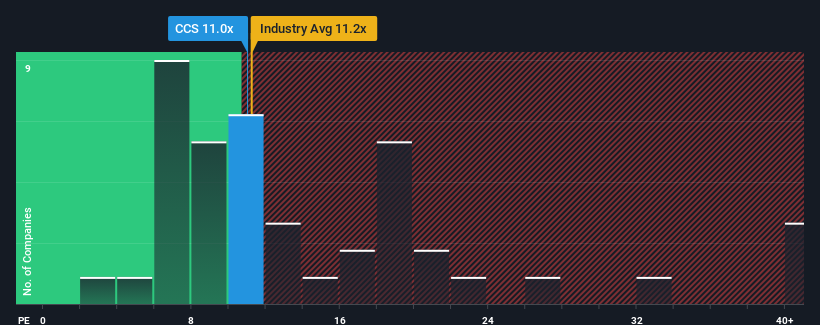- United States
- /
- Consumer Durables
- /
- NYSE:CCS
Century Communities, Inc.'s (NYSE:CCS) Shares Lagging The Market But So Is The Business

With a price-to-earnings (or "P/E") ratio of 11x Century Communities, Inc. (NYSE:CCS) may be sending bullish signals at the moment, given that almost half of all companies in the United States have P/E ratios greater than 17x and even P/E's higher than 32x are not unusual. However, the P/E might be low for a reason and it requires further investigation to determine if it's justified.
Recent times haven't been advantageous for Century Communities as its earnings have been falling quicker than most other companies. The P/E is probably low because investors think this poor earnings performance isn't going to improve at all. You'd much rather the company wasn't bleeding earnings if you still believe in the business. Or at the very least, you'd be hoping the earnings slide doesn't get any worse if your plan is to pick up some stock while it's out of favour.
Check out our latest analysis for Century Communities

Does Growth Match The Low P/E?
There's an inherent assumption that a company should underperform the market for P/E ratios like Century Communities' to be considered reasonable.
If we review the last year of earnings, dishearteningly the company's profits fell to the tune of 58%. Still, the latest three year period has seen an excellent 54% overall rise in EPS, in spite of its unsatisfying short-term performance. So we can start by confirming that the company has generally done a very good job of growing earnings over that time, even though it had some hiccups along the way.
Shifting to the future, estimates from the four analysts covering the company suggest earnings should grow by 7.7% over the next year. Meanwhile, the rest of the market is forecast to expand by 10%, which is noticeably more attractive.
With this information, we can see why Century Communities is trading at a P/E lower than the market. Apparently many shareholders weren't comfortable holding on while the company is potentially eyeing a less prosperous future.
The Bottom Line On Century Communities' P/E
Generally, our preference is to limit the use of the price-to-earnings ratio to establishing what the market thinks about the overall health of a company.
As we suspected, our examination of Century Communities' analyst forecasts revealed that its inferior earnings outlook is contributing to its low P/E. At this stage investors feel the potential for an improvement in earnings isn't great enough to justify a higher P/E ratio. Unless these conditions improve, they will continue to form a barrier for the share price around these levels.
It is also worth noting that we have found 4 warning signs for Century Communities that you need to take into consideration.
If these risks are making you reconsider your opinion on Century Communities, explore our interactive list of high quality stocks to get an idea of what else is out there.
New: AI Stock Screener & Alerts
Our new AI Stock Screener scans the market every day to uncover opportunities.
• Dividend Powerhouses (3%+ Yield)
• Undervalued Small Caps with Insider Buying
• High growth Tech and AI Companies
Or build your own from over 50 metrics.
Have feedback on this article? Concerned about the content? Get in touch with us directly. Alternatively, email editorial-team (at) simplywallst.com.
This article by Simply Wall St is general in nature. We provide commentary based on historical data and analyst forecasts only using an unbiased methodology and our articles are not intended to be financial advice. It does not constitute a recommendation to buy or sell any stock, and does not take account of your objectives, or your financial situation. We aim to bring you long-term focused analysis driven by fundamental data. Note that our analysis may not factor in the latest price-sensitive company announcements or qualitative material. Simply Wall St has no position in any stocks mentioned.
About NYSE:CCS
Century Communities
Engages in the design, development, construction, marketing, and sale of single-family attached and detached homes.
Solid track record with adequate balance sheet.


